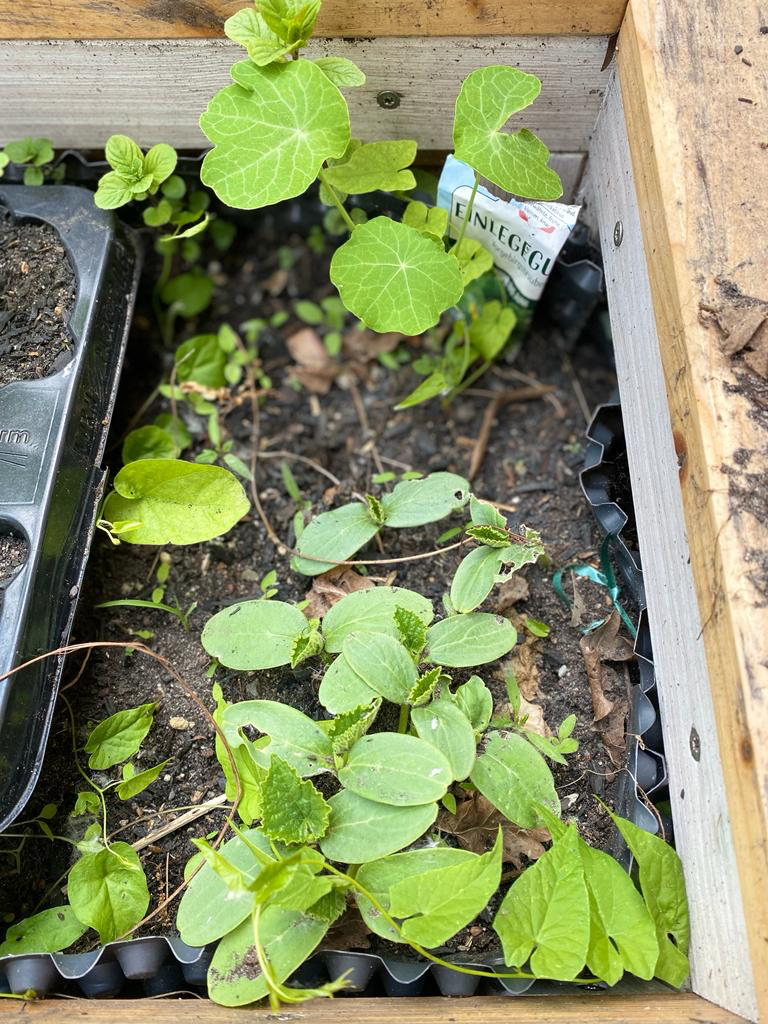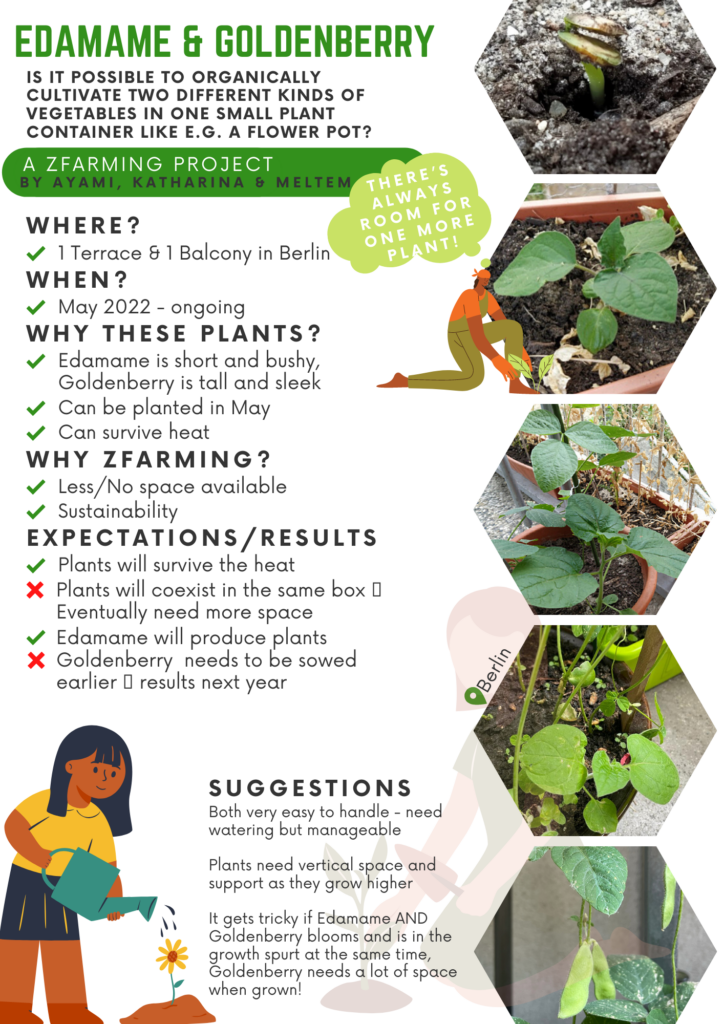For our research project, we looked at the distribution of urban gardening projects in Berlin and examined our research question “How are Urban Gardening projects distributed in the Berlin urban area and can patterns in the distribution be identified?”. During the first phase of our research, we quickly realised that urban gardening projects in Berlin are mostly organised privately and that there is no central database or similar, so we decided to investigate only a small part of the Berlin city area for the distribution of urban gardening projects and to identify possible patterns in the same time. Our choice for this project was the Sonnenallee in Berlin-Neukölln.
We wanted to know if and how many projects are realised by residents of the city along the street. We were also interested in whether there were differences in the number or type of projects at the beginning, middle or end of Sonnenallee.
All in all, we were able to find 25 urban gardening projects in the form of flowerbeds at the edge of the pavement (see the map on the right). Right at the beginning, we even met 3 people who were working on their beds at that moment:
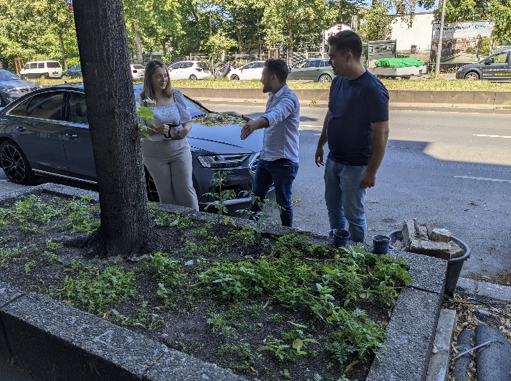
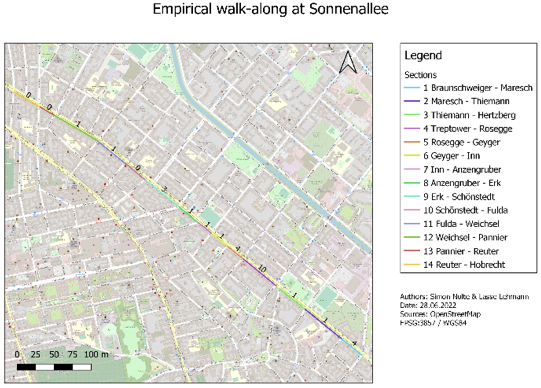
Some of the beds were in good condition and you could see that they were taken care of. You could see that most likely residents of Sonnenallee or the neighbourhood took care of the beds, and also that the beds looked different from each another. On the left is a bed which is in good condition, while on the right there is a negative example:
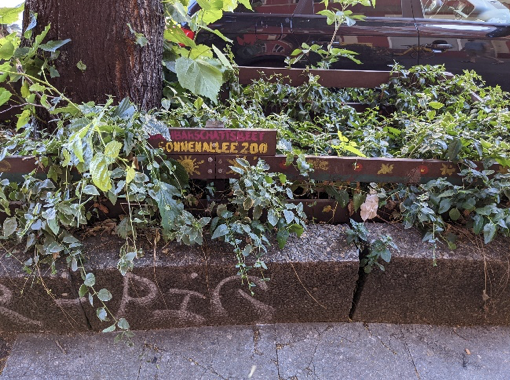
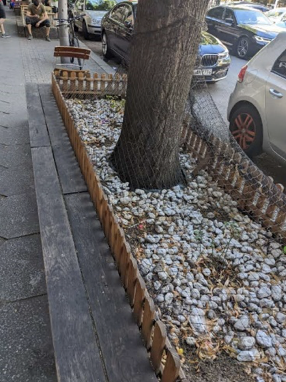
Another result of our walk was that we found more beds at the beginning of the route than at the end. This could possibly be related to the fact that the type of development at the beginning of our route is different than in the middle or at the end of the route towards Hermannplatz. At the beginning, there are few businesses, but from the middle and to the end, there are many shops, restaurants and other businesses. Generally, there are more people on the road and it is a bit „busier“. So the pattern we found in this specific case is, that the number of beds decreased in direction north-Sonnenallee. There could now be many starting points for further research: for example, connections with socio-economic structures, housing density or similar. The scope of our undertaking was too small for that, but there is definitely potential for future research.
by Janina and Johanna
What if we told you that you could eat the city that you live in? You would probably scrunch your eyebrows, make a distrusting face and shake your head… you are doing this right now?- Then you should continue to read now.
About 30,000 plants are edible worldwide. But only about 150 plants play a role in our diet and about 30 species cover 95% of the world’s daily calorie requirement (ZDF 2019). A large number of them are edible wild plants that can also be found in cities.
We asked ourselves how much knowledge the hard-working urban gardeners and city- dwellers actually have about edible wild plants. Because theoretically the salad for the hot, sunny afternoon could grow and be picked around the corner between the asphalt and masonry. But does an urban gardener or city dweller even dare? – or are there too many prejudices about the tasty green wild plants? Is it the peeing dog or the filth of the city that might put off the city- dwellers culinary interest? And where, if at all, would edible plants be collected?
All this, we tried to find out by surveying almost 50 urban gardeners and city-dwellers. In the online questionnaire, the participants could also take part in a quiz in which they could put their knowledge of plants to the test.
Results in a nutshell:
- Surprisingly many (82 %) knew edible wild plants existed and about 60% scored more than 60 % in the plant quiz, showing off with a quite good to expert knowledge
- the top three mentioned edible wild plants were nettle plant, dandelion & goutweed
- 12 % wouldn’t dare to eat them because of hygienic concerns and lack of knowledge or insufficient identification skills
- Most of the participants, in both groups, would prefer to collect in areas with little to no human interaction, like in the forest (94 %), followed by natural landscape sceneries (65%) and in parks (30%).
- Main reasons for avoiding consumption: lack of knowledge, uncertainty, hygienic prejudice like dog feces and urine
- something that everyone (100%) agreed upon is that they are healthy for you!
In order to do a little more for environmental education, we planted two raised beds with edible wild plants on the raised beds of the TU Berlin. Down below you can marvel at them and yes- the plants in this bed are all edible!!!
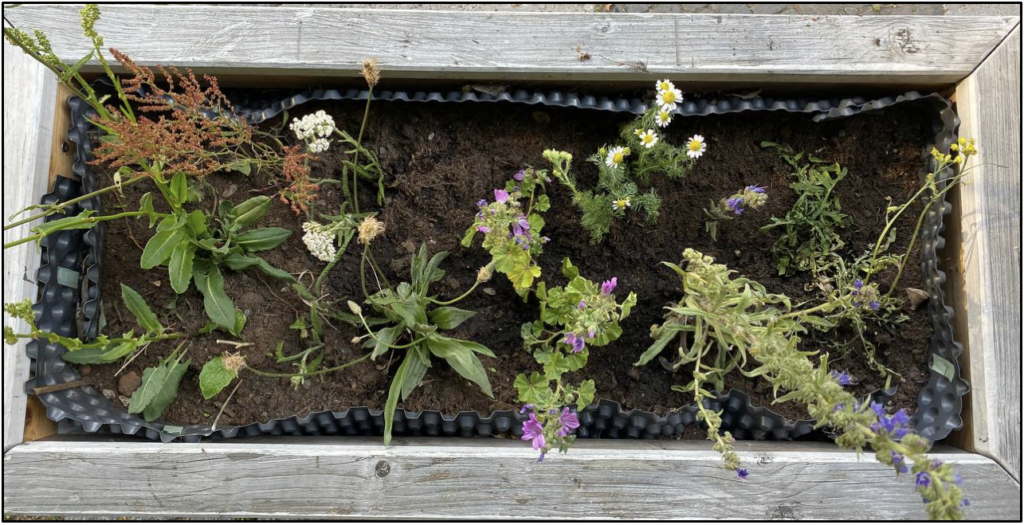
Besides, we prepared a poster that should help by-passers to learn to get to know the plants better. However, our raised beds were only able to bring joy and education for a short time, because after only two weeks our pretty edible wild plants were presumably replaced by cultivated pumpkins and other types of vegetables (see image below).

Nevertheless, you can find this poster here in this blog and we will soon start planting the raised beds again- and give it a second try…
Well, next time you are out and about in your city- please dare to have a look at the variability and abundance of all the yummy wild plants. You won’t regret it and it also comes with a lot of healthy nutrition and vitamins. After all, 100g of nettles contain 6x more Vitamin C than a lemon (Plantura,o.J). And don’t worry about the dirt and supposed urine, it’s easily washed off and does not harm you in any way.
Bon appetit.
Literature:
ZDF, 2019. Essbare Pflanzen weltweit. Online URL: https://www.zdf.de/dokumentation/planet-e/vielfalt-vom-feld-grafik1-102.html (Accessed on 21.07.2022)
Plantura, o.J., Vegetables with vitamin C: the best vegetable sources of vitamin C. Online URL: https://plantura.garden/uk/green-living/nutrition/vegetables-with-vitamin-c (Accessed on 21.07.2022)

By Juliane and Georg
Berlin is one of the densest cities in Europe and is known for its compact urban fabric of mixed-use houses that on average rise between 3-5 levels above ground. With it comes a huge lack of urban green space. The lack of urban green space made Berlin’s urban dwellers creative on their opportunities to create new public and green spaces. A public option were Tree squares or in German terms “Baumscheiben”.
For us it came with rising anticipation about how our own Communities were organizing their Green Spaces. This also coincided with the question of how we use our immediate surrounding public space. Surrounding our research effort was an attached own gardening project. This brought us the Idea to combine our observations with our own experiences.
These observations about how people use their streets and what challenges can appear can have an insight about many urban dwellers pressing into long unused spaces. Especially in times of drought and Climate Change. It can also give some advice about what can happen when you start your own gardening projects in public spaces and how in the end the public can react. We chose the quantitative observation in our own “Kiez” which seemed to be easier to do individually, since the distance between our residencies is rather far to check into one project regularly.
The differences in how available space was used mainly resulted in the differences of the building structures of the houses. Since in the Günzelkiez mostly are buildings from the prewar with more insular dense urban infrastructure with side- and garden- houses, it made gardening impossible in the back of the house. The garden projects we discovered were present in the front gardens, balconies, or tree squares.
The Weitlingkiez suffered some severe damage during the second world war, which left a lot of damaged vacant lots. Those were rebuilt in the 50’s with conventional buildings which mainly have backyards and balconies, there are no front gardens present.
That is why gardening is hidden from the public eye. There is still one horticultural colony in the midst of skyscrapers that has existed since 1783.
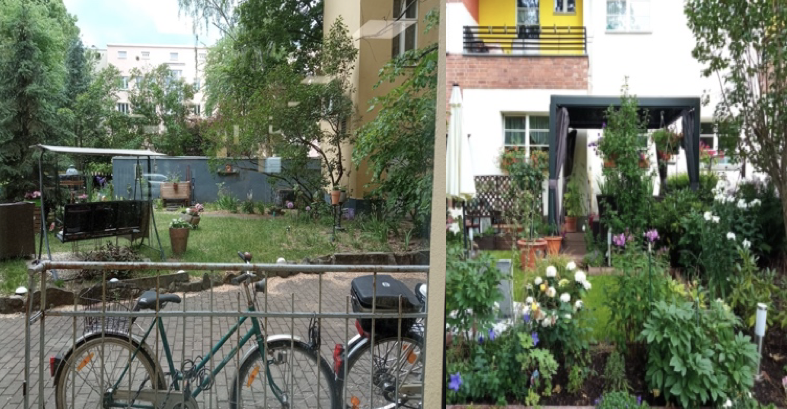

When developing our own Gardening Projects that we made a report before (blog on 11. July), we were experiencing a bunch of mixed opinions from our communities. It was interesting to observe how some people were quite radically in their opinion to extend those Gardening projects even into spaces contested by cars while also a few were neutral or even opposing those ideas of putting up high beds on Tree Squares.
But as a Resume to our observations regarding our own projects there was a colorful rainbow of opinions. What we especially examined in Wilmersdorf was that despite the opinion that mostly old and conservative people lived there, there was support for even banning cars from some contested places and using the Trees Squares for further water supply for the trees. In turn one can’t forget that you are still acting on a public space which in turn means that all opinions are not only heard but felt, with vandalism being a huge problem for those gardens.

by Min and Marion
According to the UN, 55% of the world’s population lives in urban areas and it is expected to increase up to 68% by 2050. Then a question comes directly to our minds about how we can feed all of these people living in urban areas. Because we are living in a new era where we face climate change that threatens human life especially in the agriculture sector due to drought and flood.
To adapt to the climate changes, many cities are already doing urban farming as one solution. To take good examples we will introduce New York city and Cairo in a way that both cities are vulnerable to climate change in terms of the size of population and the environment.
Firstly New York is not just a world famous city with big skyscrapers and business district images, but also it has the largest urban farming in the USA. Isn’t it amazing? And Cairo is the second largest city in the African continent which recently promoted urban rooftop gardening proactively by the government to adapt to climate change and to have food sovereignty.


Scrutinizing all the impacts, we can say all the impacts by urban gardening in both cities are very much positive. So we collected qualitative data in terms of some categories: Governance, community benefits, Awareness and commitment, Adaptation measures, Mitigation measures, R&D, Health and Food security. Then we found common areas and differences between the two cities as the diagram shows.

New York started urban farming in 1978 and has developed more in the R & D area as well as more funding thanks to the GDP size. And heaps of workshops help citizens have public awareness. On the other hand, Cairo had some resistance from the inhabitants due to unfamiliar concepts and funding with skilled expertise were not enough. There are more poverty and development issues.
However, the two cities are tackling urban gardening in different ways and trying to make common reasons of adapting to climate change and to create a healthy lifestyle
To sum up, although Cairo and New York have contrasting GDP and the urban gardening culture started in different years (1978 – New York and 2000 – Cairo), the two cities match their ideologies in at least 40% of the categories.The most common factors that influence the development of urban gardens are funding and education.The level of economic development in Cairo affects the use of urban gardens for different purposes like employment and poverty alleviation.
by Simone and Cornelius
Imagine a disused airport field in the middle of the city. You could walk from runway to runway over vast grassy areas, be “mad-max” with a rocket strapped to your back and roller skates on your feet, build the biggest urban garden project – but all that stops you is a huge fence.
In 2008, that was exactly the situation at Tempelhof Berlin. Several thousand people demanded the airport to be opened to the public, demonstrated, and lastly were heard, thus fields were opening. With the same attitude and drive for action Allmende-Kontor e.V established in 2011 the biggest urban garden project with now more than 250 raised beds on the plain fields of Tempelhof.
Wow! That attitude got us interested, now 10 years later, what utility the garden provides for its community. To address this, we conducted a Survey with qualitative and quantitative questions.
Through several question areas, where participants were asked to answer according to their experiences with the urban gardens in Tempelhof, lasting from topic areas like wellbeing, garden-maintenance, gardening in general and park organization, we approved the following hypothesis: Urban Gardens enhance collective wellbeing.
We asked 44 people, and…
… 53% think gardening in general has a balancing effect.
… 98% feel safe and secure in the urban garden at Tempelhofer Feld.
… 9% wish more separation between the gardens and the park activity.
… 88% say that music, skateboarding and partying are part of the positive ambience of the gardens at Tempelhofer Feld.
… 98% consider urban gardens to be aesthetically pleasing.
Let’s put numbers aside and say it in words: The gardens at Tempelhofer Feld are an optical enhancement of the park and fit perfectly in the surrounding. Furthermore, people feel safe while enjoying some kind of nature amidst Berlin. Park activities and gardening harmonize next to each other and ensure wellbeing.
If you’ interested in gardening, the Allmende projects and workshops – check this out:
https://www.allmende-kontor.de/
And if you are curious about our garden project at Tempelhofer Feld here are some pictures:
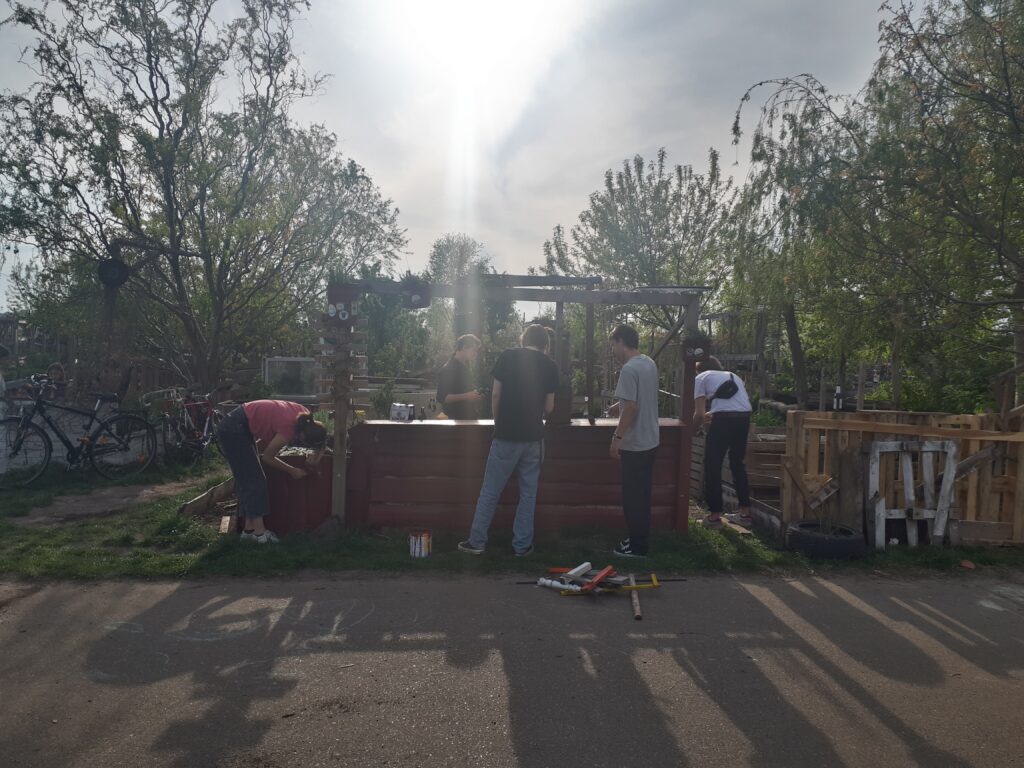
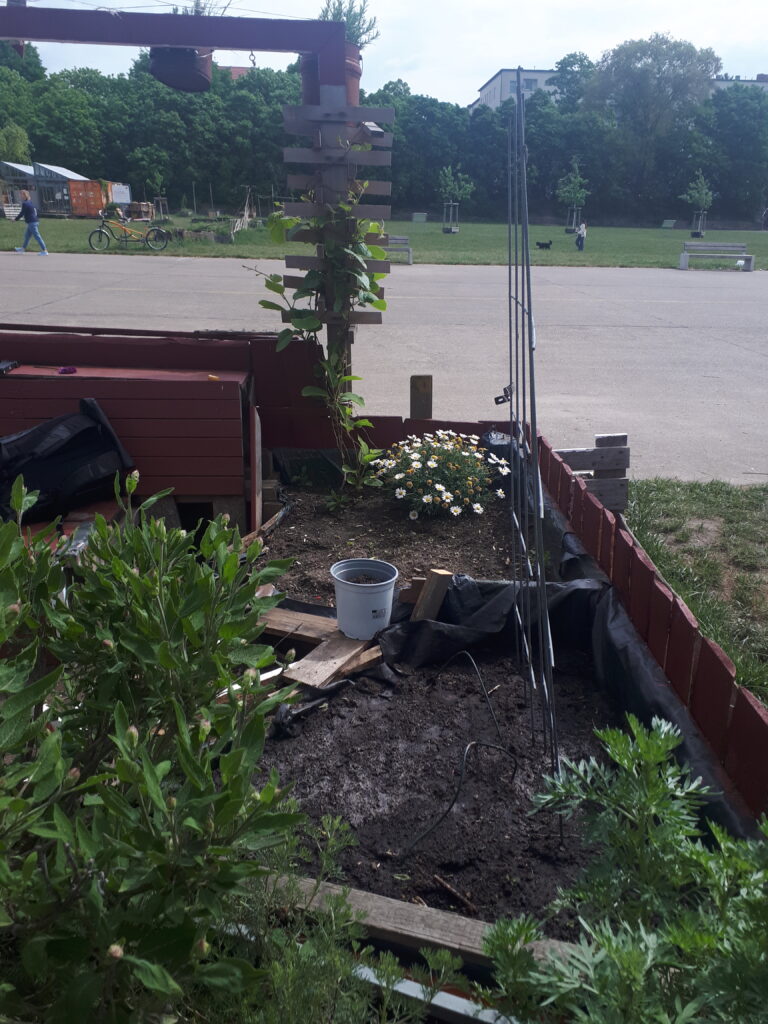
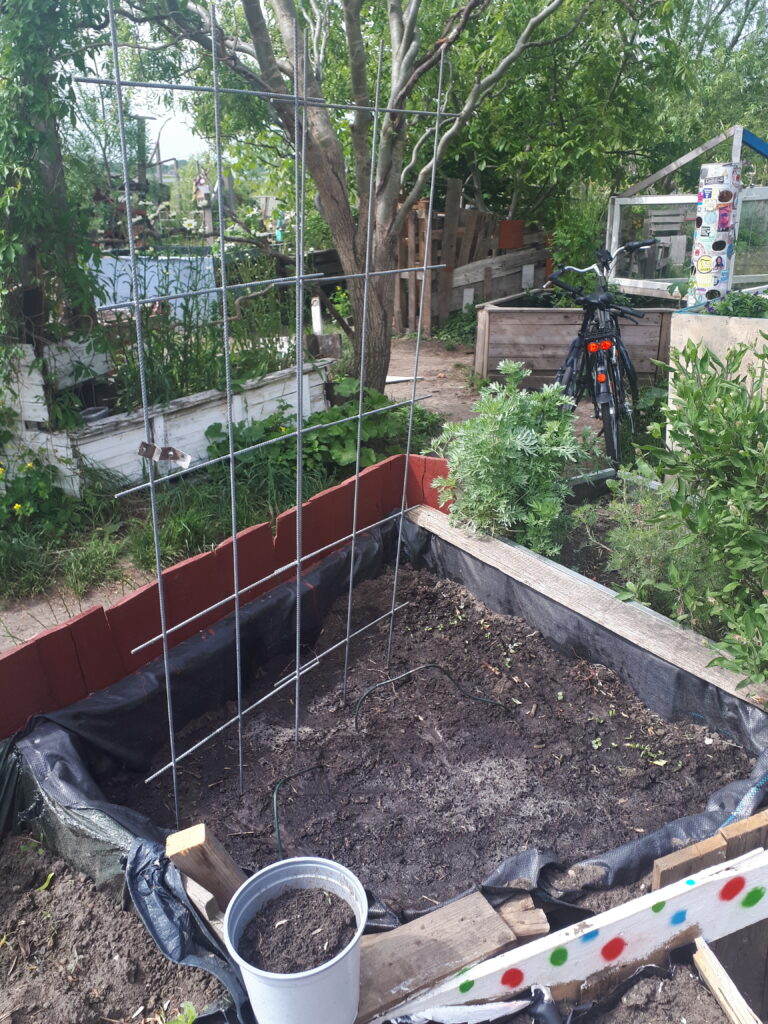
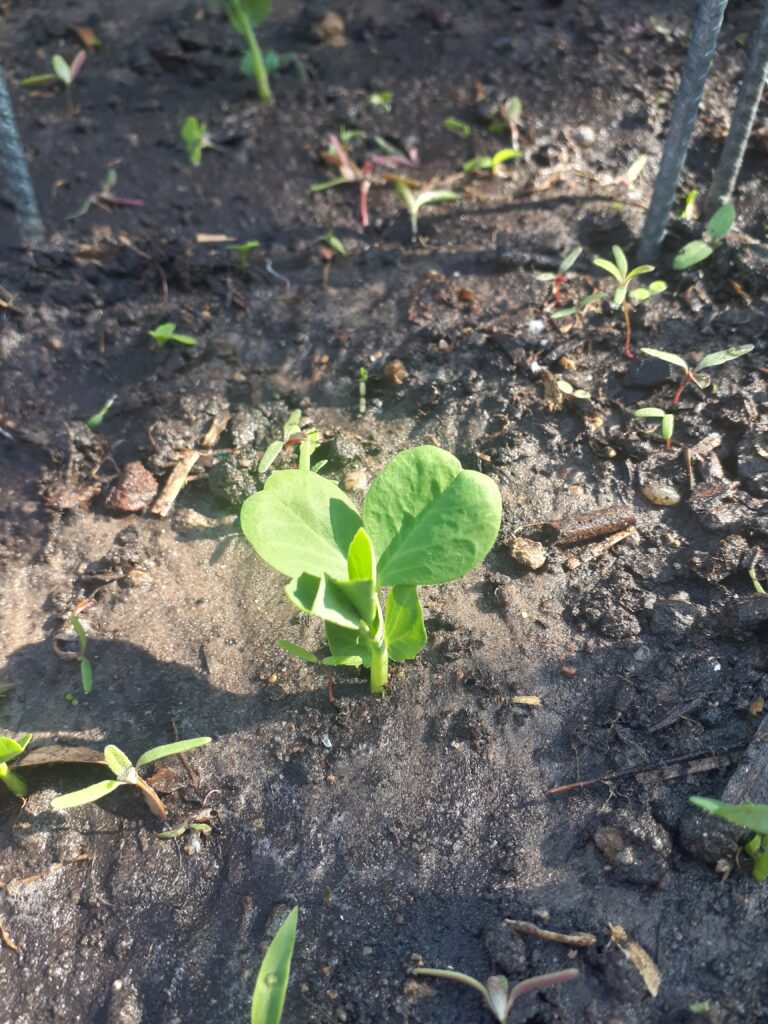


by Anna, Fiona and Iqra
In this final blog post, we would like to describe our experiences from this semester and share results that we gathered from our guerilla gardening experiment. The starting point of our experiment was the concept of the guerilla garden, especially, how to protect and guard a guerilla garden in the hustle and bustle of a public city street. We wanted to evaluate how effective physical barriers (like fences) and signs would protect the growth of our vulnerable plants in public. Plants can be damaged in public in many possible ways, such as people stepping on them, driving over them, littering, pet feces and harsh weather.
Our experiment has implications for the protection of guerilla gardens worldwide. And although the experiment was quite preliminary and not executed at a large scale which would make it very scientifically precise, we think it still draws important conclusions and insights into the maintenance and survival of urban gardens. With the impacts of climate change looming over all urban dwellers, the preservation of urban green spaces – even if they’re as small as local guerilla gardens – can still be valuable in terms of the microclimate, water retention or in the case of guerilla gardened trees, carbon sequestration and shade. For this reason, exploring how to best protect urban gardens is in the best interest of all urban communities.
As we mentioned during our presentation, we used 4 different sites for our experiment:
- No fence, no sign
- Fence, no sign
- No fence, sign
- Fence and sign
To record our results, we decided to take pictures and log our observations in a diary, mainly into 4 different categories: All good, Trash, Wow, and Destruction:
- All good = All plants respected. No trash found. No vandalism.
- Wow = Observed people actively respecting the plants
- Trash = Trash found on side
- Des.: = Destruction, meaning sometime got destroyed/broken
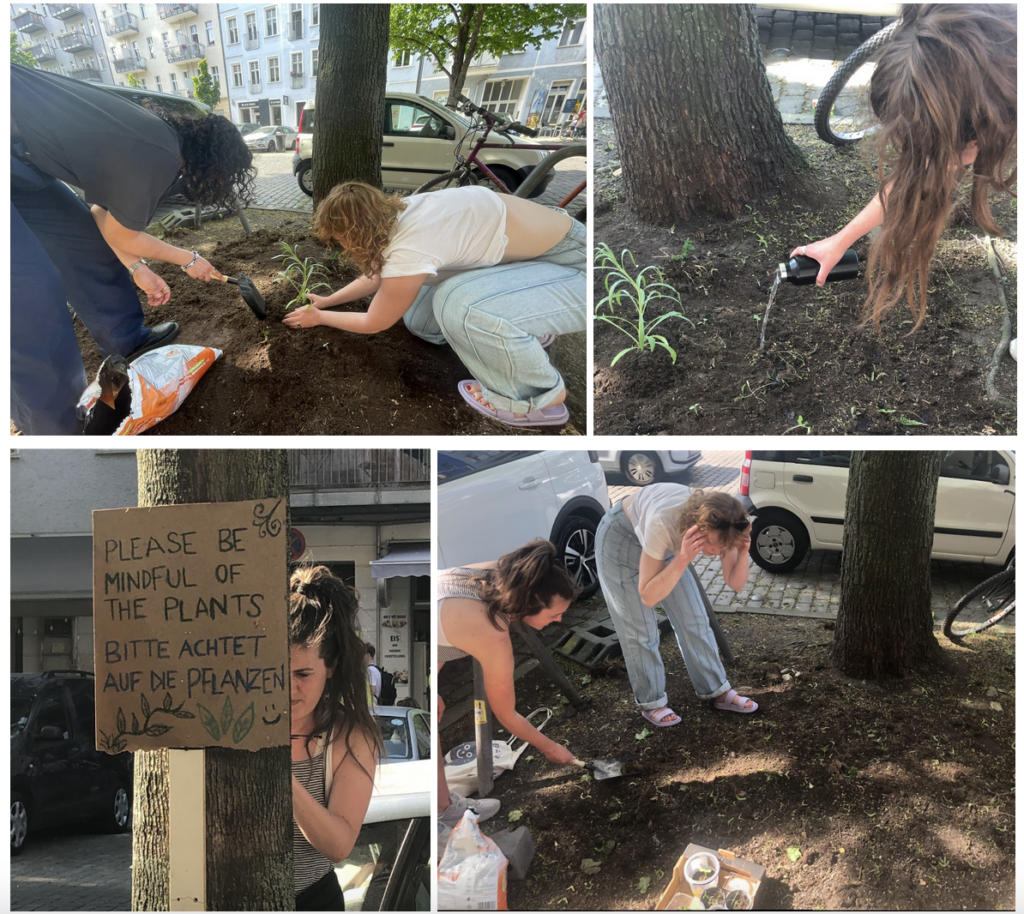
51% of the time we made an observation, everything was alright. 35% of the time, there was trash. On two occasions for the signed and signed+fenced locations, respectively, we noticed people were actively making sure not to disturb the plants by stepping on them or allowing their dogs to poop on the plants. On two other occasions, we noticed destructive activities on the sites without fences and signs. Figure 1 below summarizes our observations in a chart.
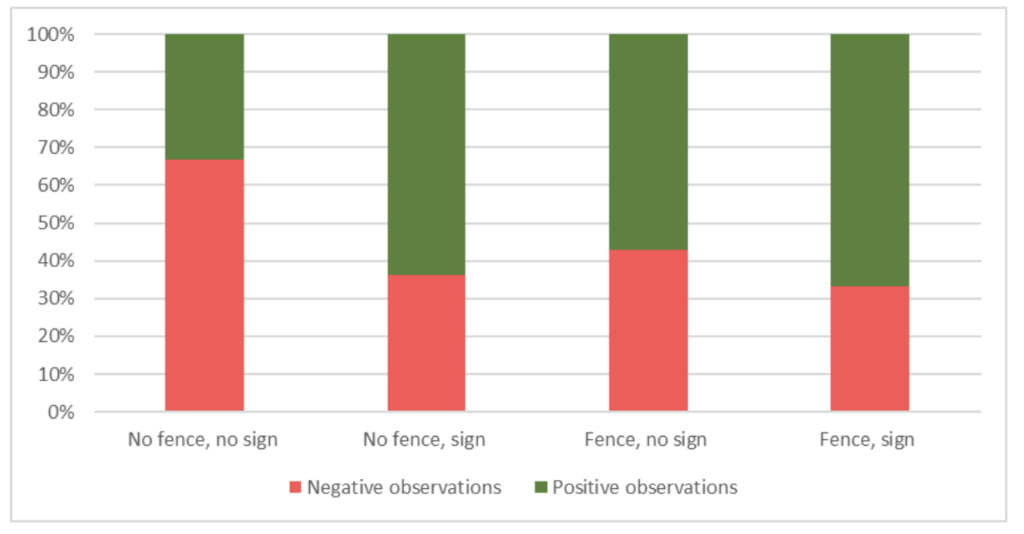
Generally, our findings indicate that if you want your guerilla garden to be as protected from harm as possible, put up a sign and a fence! Some extra points to consider that we couldn’t cover in our experiment due to time constraints: how big the fence is, how many signs or what type of signs, a deeper analysis of where to place the guerilla garden in the first place. There are many other factors that could play a role in the survival of a guerilla garden, and since they are in public, anything could happen to them! In this regard, we can’t even anticipate every possible outcome of a guerilla garden. So in the end the best thing to do is just plant what you can, protect as much as you can and hope for success!
Since June we are Preparing our own Gardening Projects:
We have been examining the reactions of our own kiez communities in Lichtenberg and Wilmersdorf. Trying to understand how people react to guerilla type gardening projects and in the end how they materialize in our Kiez (neighborhood).
Jule will be hijacking one of those “macgyver” garden beds. It seems like someone (sadly not so much visible in the pictures) has put some painted pavement stones around the tree squares. First Picture was taken on the 2nd of June.The second Picture was taken on 7th of July.
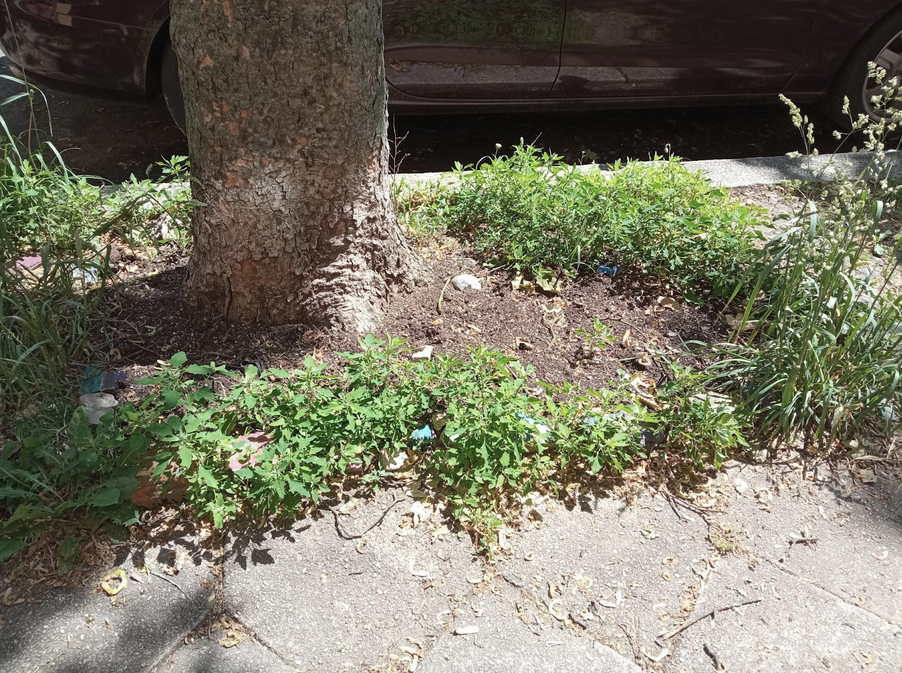
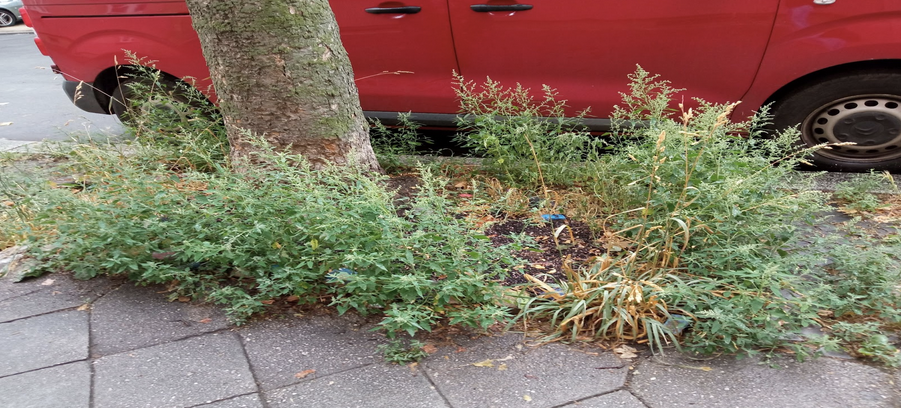
I took pictures of the already existing plants there and ran them through google lense. The outcome was:
There is a lot of red clover,which provides enough nutrition for bees and some seedlings of celandine poppy. So since there are 2 of those “Do it yourself garden beds”, I decided to plant some flowers on one garden bed (which is not in the pics right now) that attract butterflies and since the other one (in this picture) already has some flowers that attract bees,some additional greens.
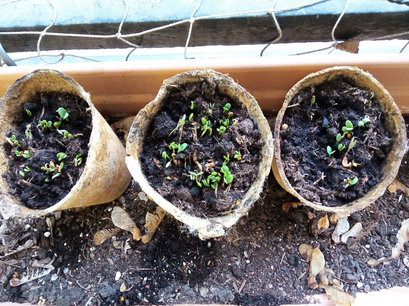
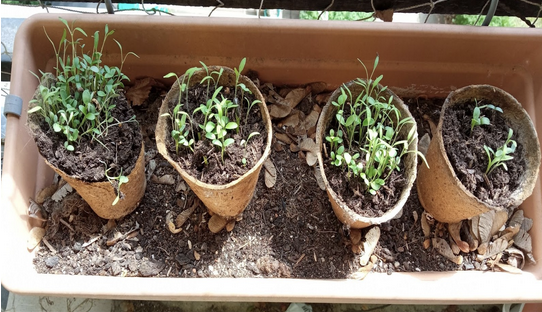
Since the Weather was rather unpredictable I decided to pre grow them on the balcony. Left side was taken on the 5th of June, the right side was taken on 8th of June. In addition to the “wild flower” mix, I’ve decided to pre grow sun flowers.
As you can see, all of them got very sunburned despite watering everyday and tried to keep them away from too much sunlight. The 4th batch by now sadly is dead.
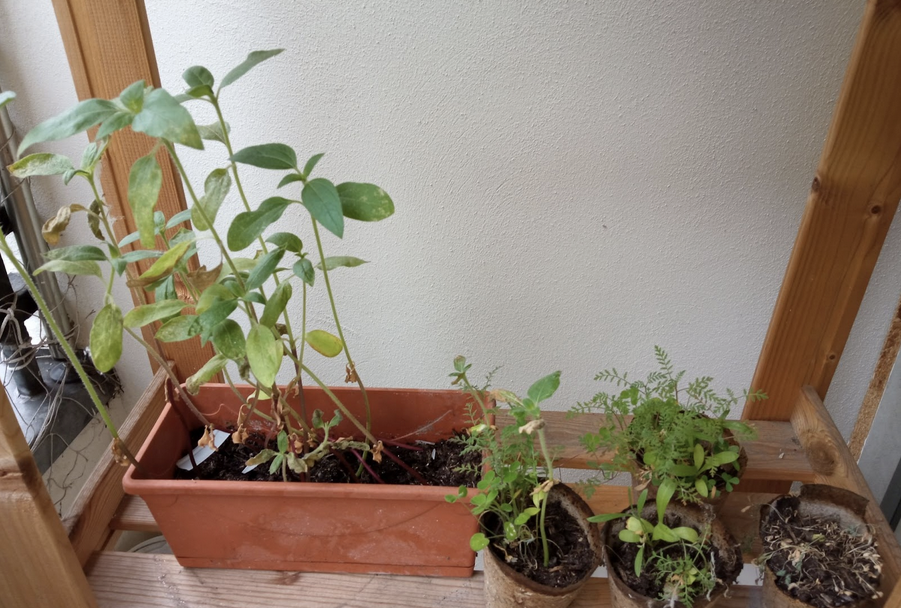
Since I’ve had some additional soil I decided to bring some “almost dead” potatoes (yes sorry i forgot i had them) back to life, just to have something to show as progress.
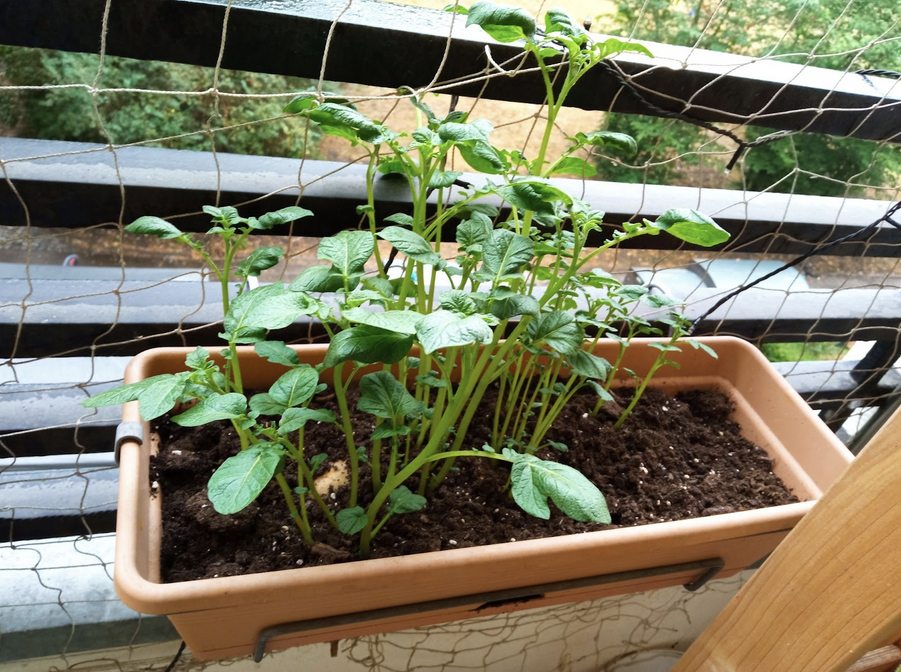
In the sense of our original plan to observe the reaction from the neighborhood i have nothing to show off yet, but on my scout missions for the “perfect space” i’ve noticed,that in this neighborhood people do seem to care about ways to create beauty (sometimes in unusual ways) in front of their homes, within a dense housing situation:
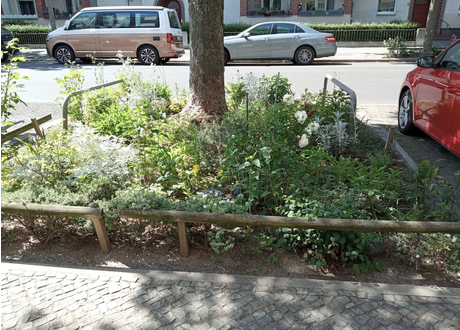

I will let you know what will be the reactions (or if there are any) when I finally get to set the green little oxygene factories out into their natural habitat.
Georg has been building a small raised bed by his own front door with help of a friend from my old home town of Leipzig.
Day one of building a own raised bed from a Europalette was kinda hard as we only had simple tools to work with.

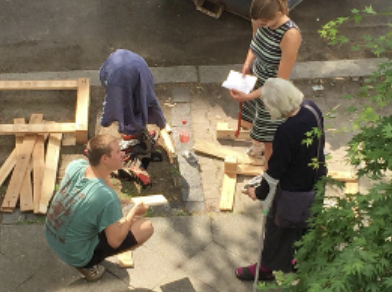
We were detaching the Pallet parts and afterwards reattaching the parts back together. It took far longer than expected.
Already on the first day we garnered attention from my house community. Getting books and wooden material to work with.
Day Two of building an own raised bed we continued to work towards finishing our Project.
Also on day two the Project’s sight caused attention by walkers and bystanders asking questions about what we were doing.
All were positive or at least neutral about my project idea. day one and day two were on 04. and 07. of June
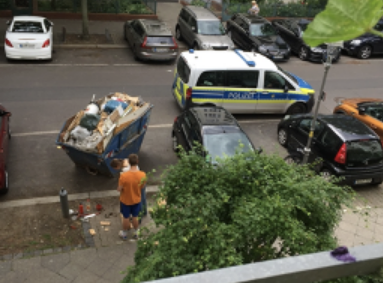
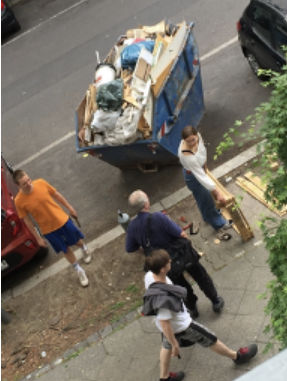
Day three was about finishing the Project.
It was strongly delayed due to Corona and other Illnesses caused by a Festival.
I was in need of additional wood, so I bought it at a local Bauhaus store together with the earth (120l of earth + 3 Parts of Wood each 1m long) for abou 21€.
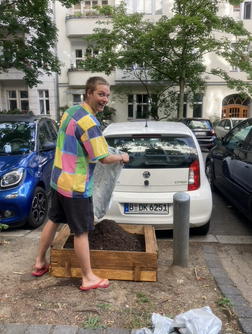
After finishing the raised bed it was great to see the first reactions of community members and dwellers of my street in the Kiez (more in the Presentation on Wednesday) With the new raised bed what was intended was not only to make the street more beautiful but also to protect the trees with their huge roots from cars parking on their roots. How this will end up is still to be questioned.
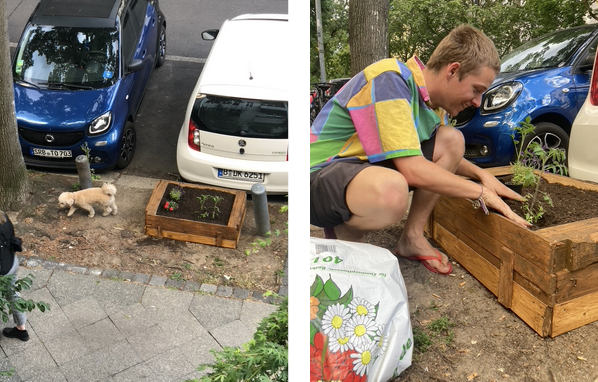
In the raised bed there is now a variety of plants with some additions to the three plants planted in the beginning. The first three plants were two Tomatoes and one Lavendel. Additions were not only made by me but also by people I don’t know. Which is great to see that the garden is also used by others.
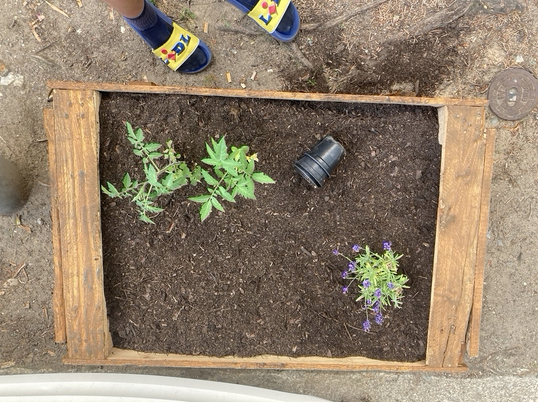
In the last blog post you have read, and seen, the latest updates from the raised beds at TU. Yet some tandems are also making progress outside of the TU grounds.
Triqi, Anna and Fiona, for instance, have started their guerrilla gardening experiment in early June:
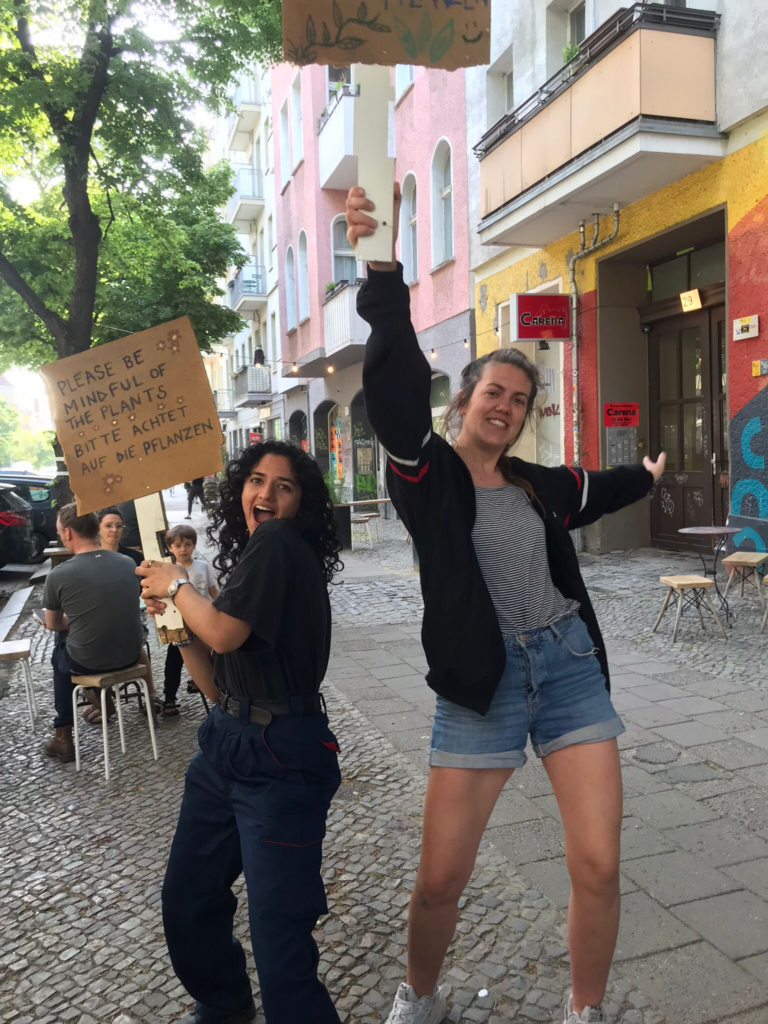
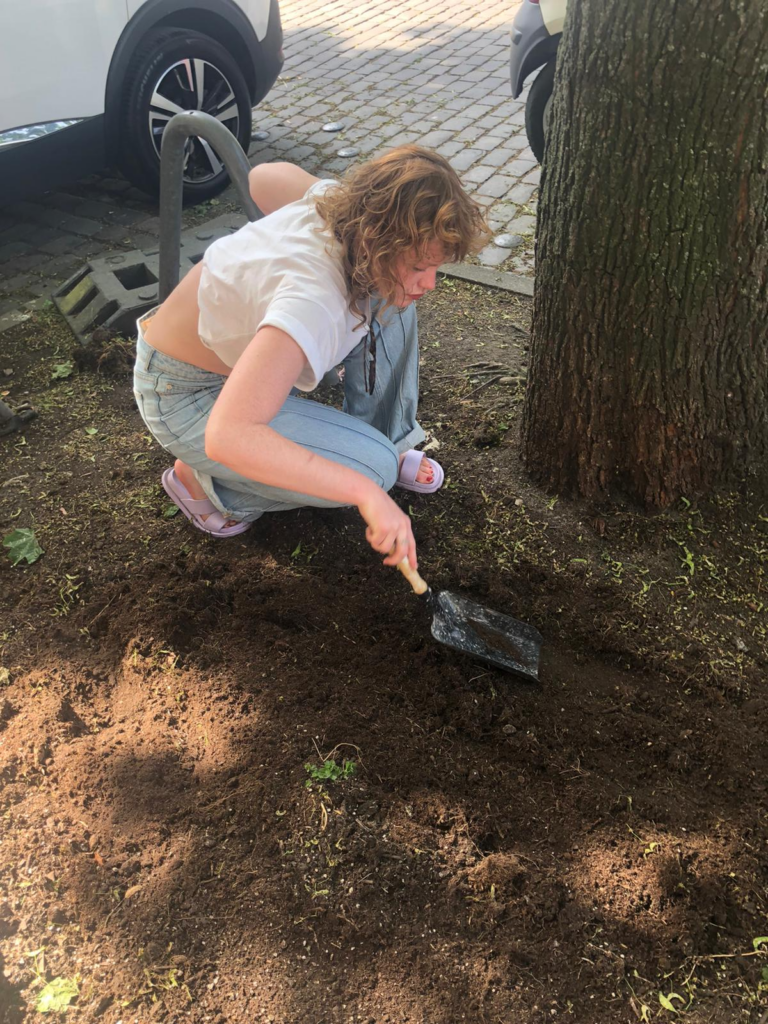
Under the premise of observing, if and how much fences and signs protect guerrilla gardens the team has created/chosen 4 experimental sides:
- No fence, no sign
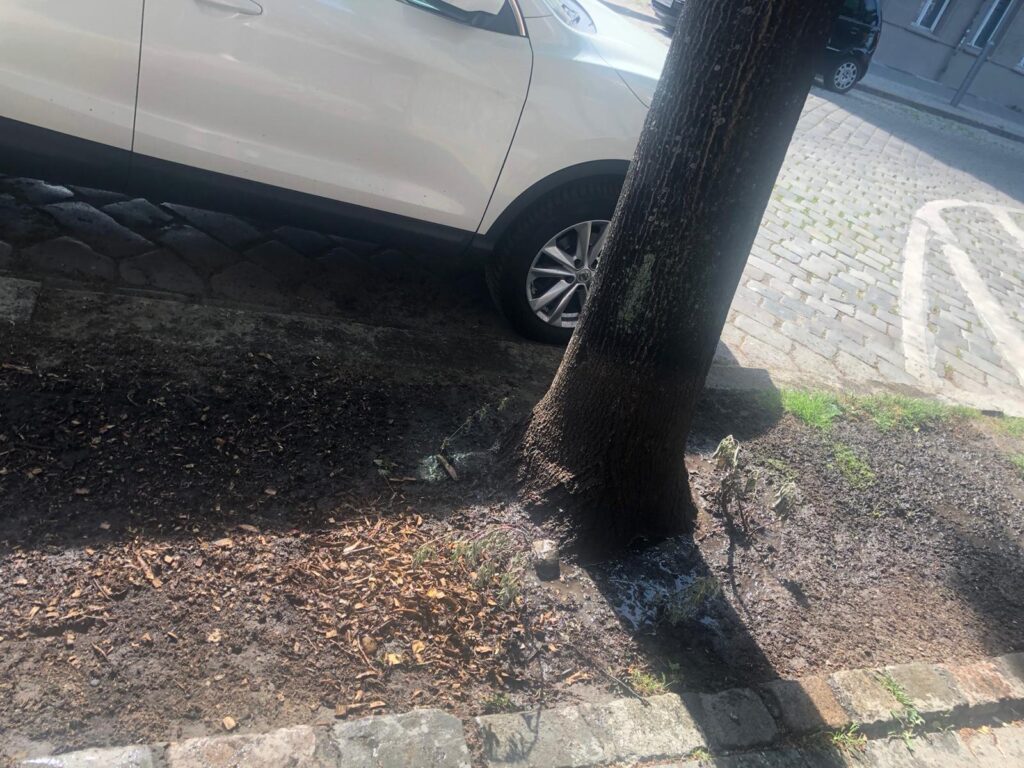
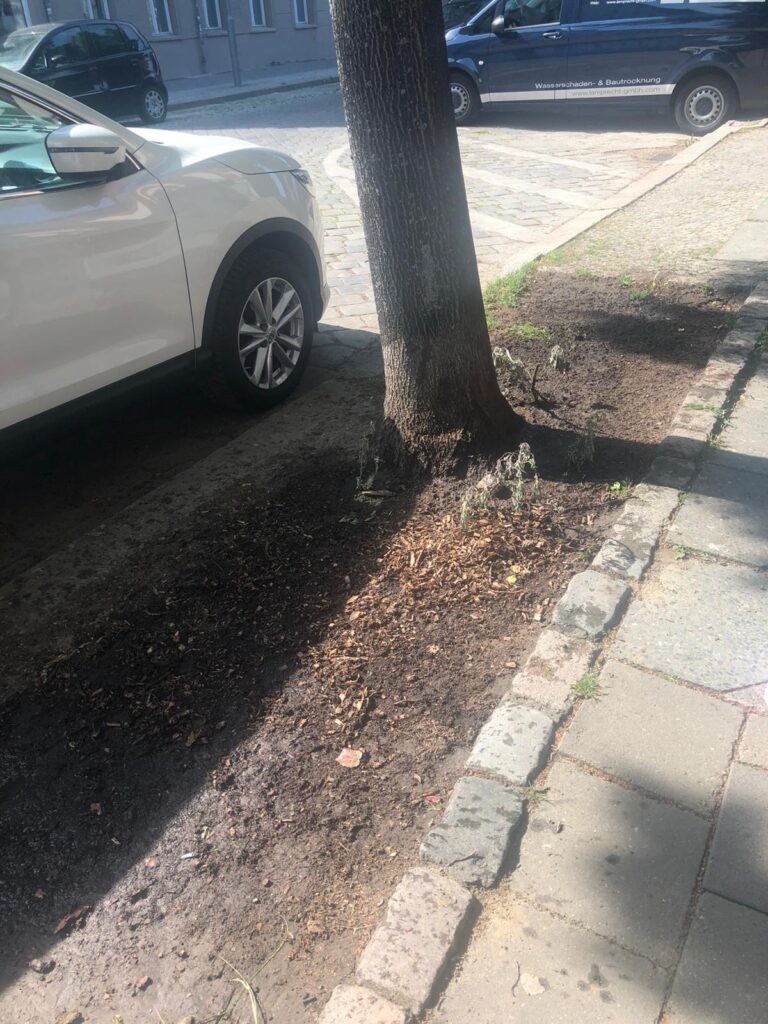
2. No fence, sign
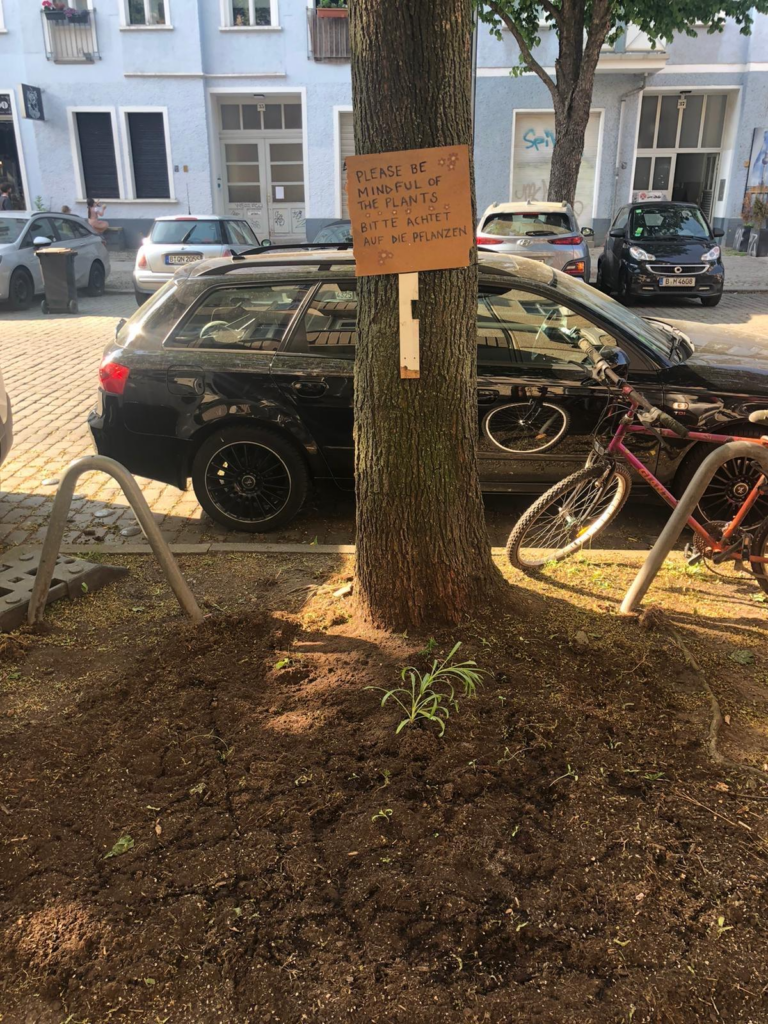
3. Fence, no sign (no photo yet)
And
4. Fence and sign (no photo of the side with sign and fence together)
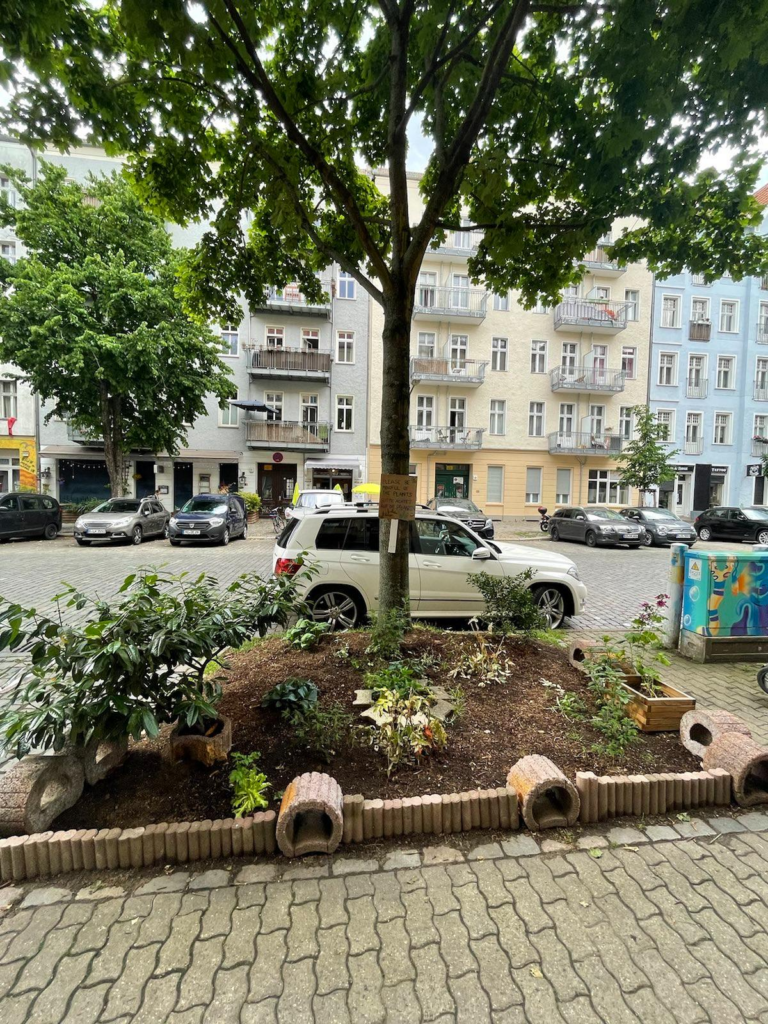
And elsewhere?
On Tempelhofer Feld, Cornelius and Simone have started to paint their garden red in late April.

The idea was to see the plants growing from the beginning on so they bought seeds and planted them in the beginning of May.
With a team of Leuchtstoff and friends they decided where to plant and what to plant.

Below you can see their space, marked in red. The green dots are corn, the yellow ones are peas and later on, if there is space in between the plants, pumpkin will join them, which is marked in blue.

The bed is getting greener and greener – however Simone & Cornelous were wondering, whether the other plants inbetween are weeds (which would need to be removed) or not. Maybe one of you has an advice on that?
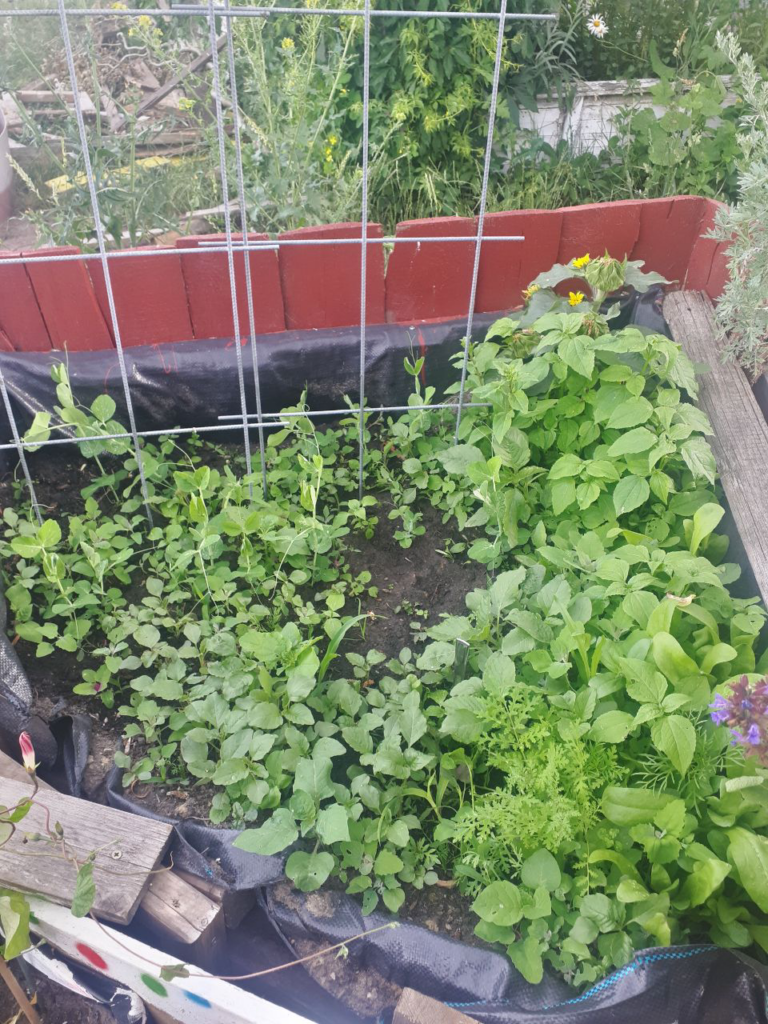
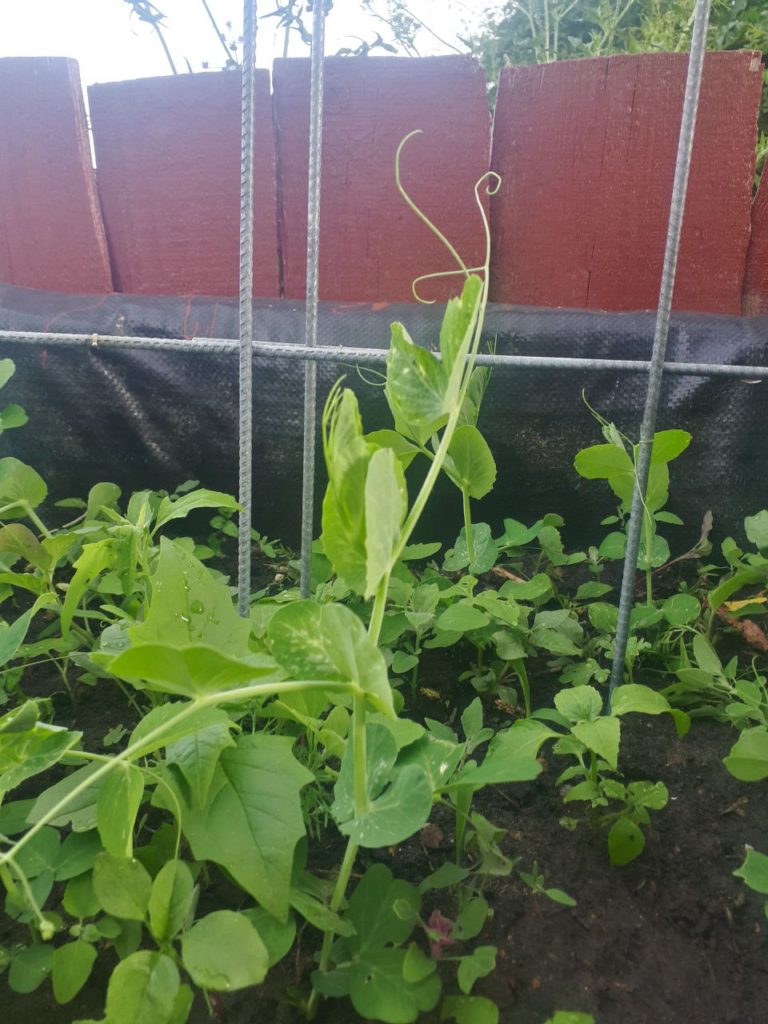
Many teams have reported that their „red“ plants are growing, blooming and ripening: strawberries, tomatoes, beetroot, raspberries.
For instance, Luisa’s and Cornelius‘ beetroot showed some noticable growth, visible in the pictures taken only one week apart below.

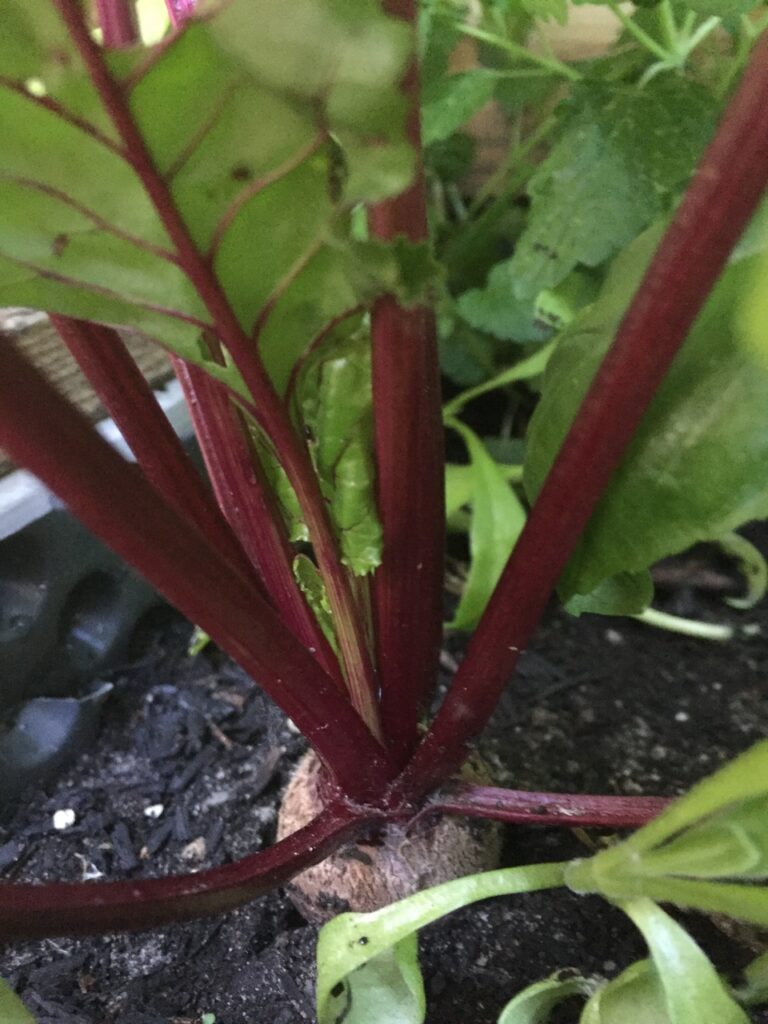
The same development could be seen by their kohlrabi and their TUmato developed well, too:
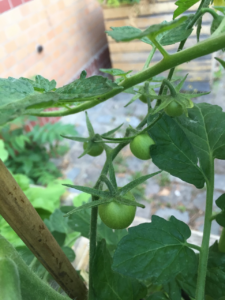
Excitingly, they spoted the first raspberries and strawberries in the beds of our neighbors, which could have been Ayami’s, Katharina’s and Meltem’s whose baby strawberries and TUmatoes you can see here:
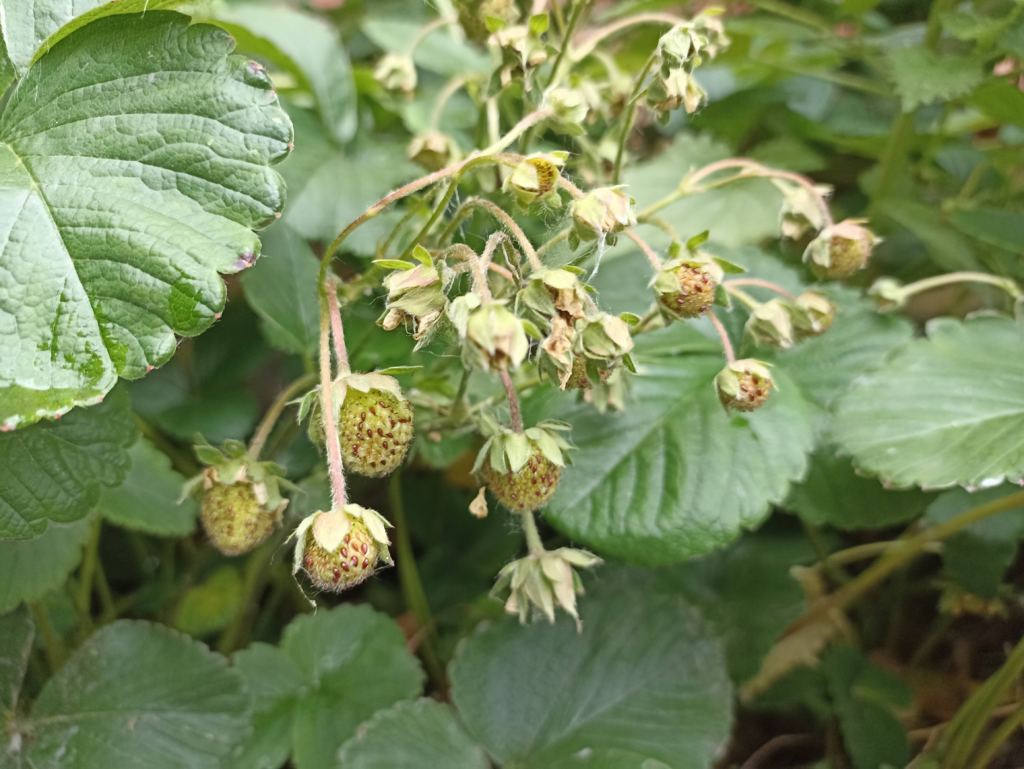

However, both tandems ran into some „issues“ as well: only one of Luisa’s and Cornelius‘ seeded beans has grown and they realized that it is slowly getting crowded in the bed with the beetroot and kohlrabi because the lemon balm is driven out. On the other bed, Ayami, Katharina and Meltem need to take the nettles out, but for that they need to bring the a proper pair of gloves.
Moreover, Simon has removed the unnecessary plants, probably weeds, and planted strawberries as well as a cucumber, as you can see in the following picture. Red seems to be in favor again, as he plans to add some chilis and tomato.
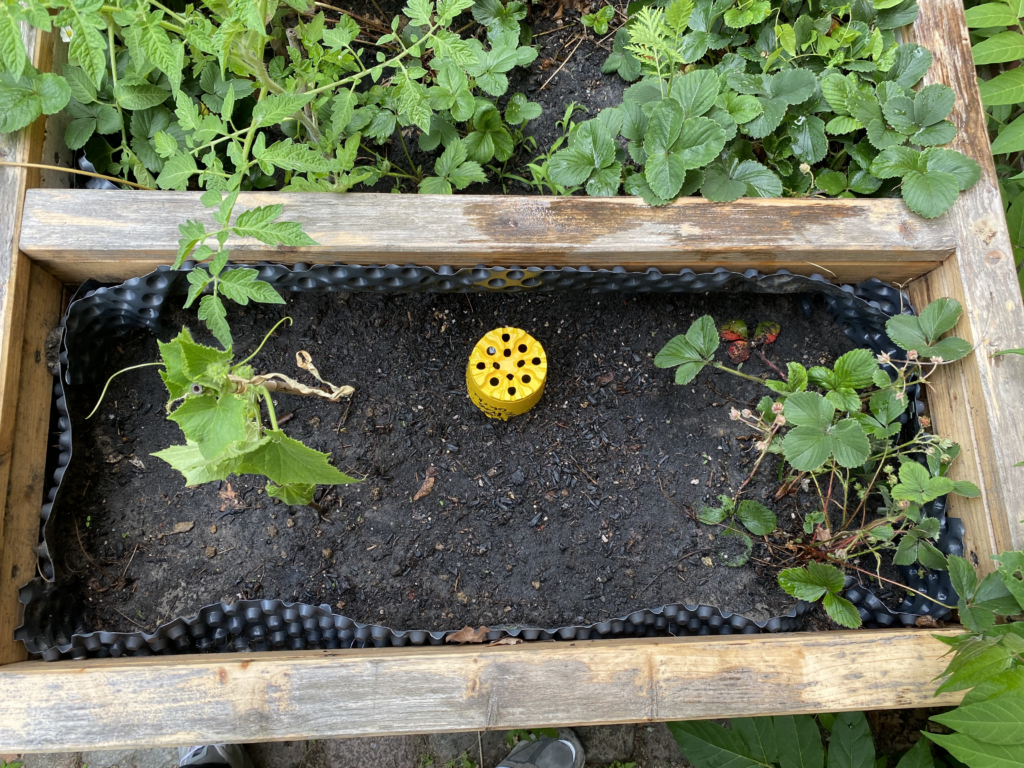
Lastly, Min Kim and Mario have planted red (and white) radishes, monks cress and „Einlegegurken“.


